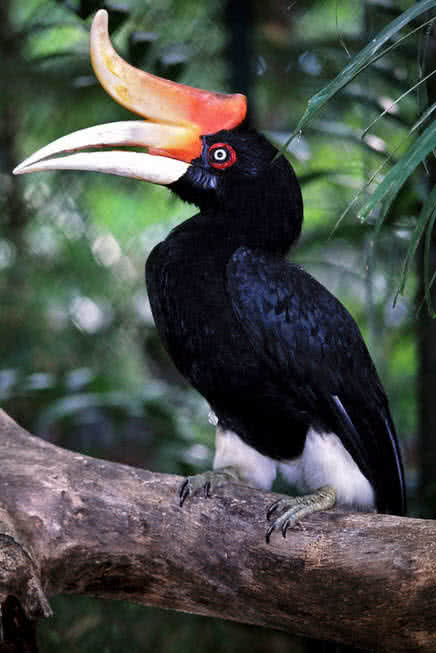
This is especially important when living in a noisy forest and you are trying to reach your partner over all the other sounds. Since the casque is a primarily hollow structure, it allows for resonance to occur, helping to amplify and carry the calls of the species. The most prominent explanation for the rhinoceros hornbill casque is sound amplification. Now that we know what it is, let’s talk about why. Sometimes, it can take up to six years for the casque to be fully developed and cosmetically colored!

This is the same oil that birds would use to help condition their feathers during preening. The bright orangish-yellow color that we see vividly on Bob and Nancy are the results of the buildup of the preening oil secreted from their uropygial gland, that pimple-like structure at the base of their tail. As the chick is growing, the casque (and beak for that matter) are white. Even more interesting, is perhaps the coloration of the casque. They do not have fully developed casques until they are close to maturity. So, one way to tell our male, Bob, from our female, Nancy, is to look at this structure.Īnother interesting thing is that chicks do not hatch with casques. Males, who tend to be slightly larger in body size than females, also follow the trend of having larger casques. Other species include cassowaries, certain fowl, and several species of curassow.įocusing on the rhinoceros hornbills, there are several interesting things to point out about the casque. And though our hornbill species are currently the only bird species at Zoo Atlanta that are in possession of this anatomical structure, they are not alone. All 54 species of hornbills have some form of a casque including our southern ground hornbills, though theirs is more of a protruding ridge rather than a well-defined structure.Ĭasques are extensions of the upper mandible or skull, typically composed of keratin, the same stuff as our nails. The hard structure found on the rhinoceros hornbill is called a casque. Toucans are native to Central and South America, while hornbill species are native to sub-Saharan African and Asia.Īs for the “two beaks.” First, it is important to know that the beak is the exterior layer that covers the upper and lower jaw of the bird it is what we see as their mouth. Often, our guests have seen the rhinoceros hornbills and think they are a giant toucan with a “thing on its face.” And though they do resemble toucans with their large colorful beaks, unfortunately neither are related beyond being birds. This feature comes from hadrosaurids from more than 60 million years ago.“Why does it have two beaks?” A common question, or some iteration thereof, that can be heard almost daily at the viewing window of our rhinoceros hornbill habitat.

Rhinoceros hornbills have one of the largest and most impressive casques.It is believed that it acts as a resonating chamber and helps birds to sound loudly across a large distance. Rhinoceros hornbills' casque is made of keratin and is hollow inside.At the age of 6 years, the casque and bill become orange and red this color comes from preen oil which birds rub on from the preen gland above the tail during grooming to help keep their feathers healthy. Rhinoceros hornbills have a huge casque and bill which are white in color when birds are born.The Rhinoceros hornbill is featured on the reverse of the 5 Malaysian ringgit bill.Contrary to some misunderstandings, the Rhinoceros hornbill does not represent their war god, who is represented in this world by the Brahminy kite.



 0 kommentar(er)
0 kommentar(er)
